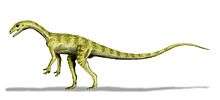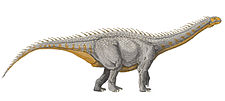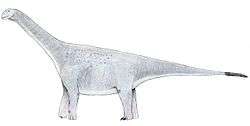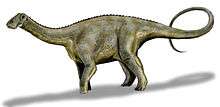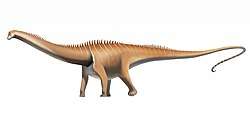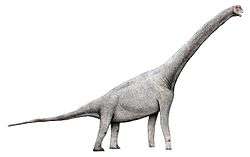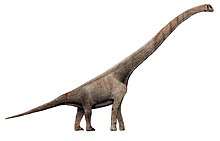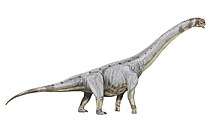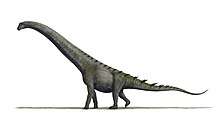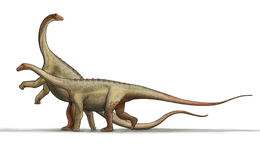Unaysauridae
Unaysauridae is a family of basal sauropodomorphs from the Late Triassic of India and Brazil.
| Unaysaurids | |
|---|---|
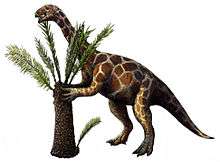 | |
| Restoration of Unaysaurus | |
| Scientific classification | |
| Kingdom: | Animalia |
| Phylum: | Chordata |
| Clade: | Dinosauria |
| Clade: | Saurischia |
| Suborder: | †Sauropodomorpha |
| Family: | †Unaysauridae Müller et al., 2018 |
| Genera | |
Diagnosis and systematics
Unaysauridae was defined by Müller et al. (2018) as the most inclusive clade including Unaysaurus tolentinoi, but not Plateosaurus engelhardti nor Saltasaurus loricatus.[1]
Members of Unaysauridae are diagnosed by a substantially expanded cranial part of the medial condyle of the astragalus, as well as a promaxillary fenestra. Unaysauridae is sister to Plateosauria, more derived than Nambalia, Thecodontosaurus ISI R277, Pantydraco, and Efraasia.[1] Unaysaurus and Jaklapallisaurus had previously been assigned to Plateosauridae by prior authors.[2][3]
gollark: You never know until you know.
gollark: Manufacturing silicon stuff is very hard.
gollark: That's actually *probably* true realistically?
gollark: The other bad part, in my opinion, is that it's expensive to just plonk down a computer to control some small system.
gollark: They have nice bits, but if you just want a simple cheap thing for 3D printer control then CC can be better.
References
- Rodrigo Temp Müller; Max Cardoso Langer; Sérgio Dias-da-Silva (2018). "An exceptionally preserved association of complete dinosaur skeletons reveals the oldest long-necked sauropodomorphs". Biology Letters. 14 (11): 20180633. doi:10.1098/rsbl.2018.0633.
- Leal, L.A.; Azevodo, S.A.K.; Kellner, A.A.W.; da Rosa, A.A.S. (2004). "A new early dinosaur (Sauropodomorpha) from the Caturrita Formation (Late Triassic), Paraná Basin, Brazil" (PDF). Zootaxa. 690: 1–24.
- Fernando E. Novas; Martin D. Ezcurra; Sankar Chatterjee; T. S. Kutty (2011). "New dinosaur species from the Upper Triassic Upper Maleri and Lower Dharmaram formations of central India". Earth and Environmental Science Transactions of the Royal Society of Edinburgh. 101 (3–4): 333–349. doi:10.1017/S1755691011020093.
This article is issued from Wikipedia. The text is licensed under Creative Commons - Attribution - Sharealike. Additional terms may apply for the media files.
